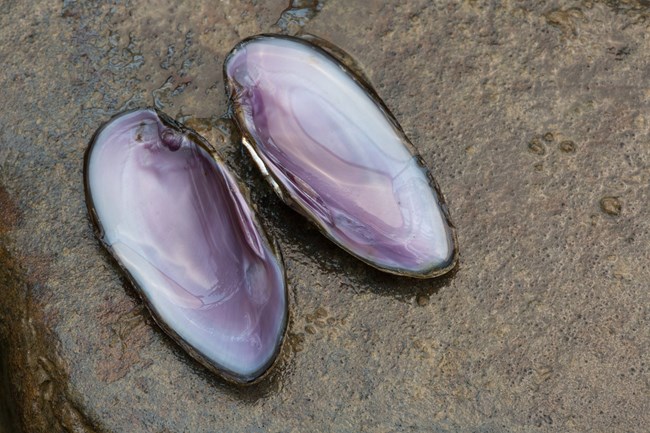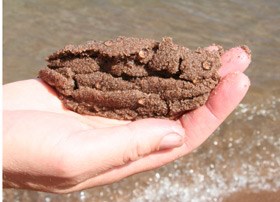
USFWS photo Small, but Vitally Important!In addition to insects and their relatives, many other forms of invertebrates live within Pictured Rocks National Lakeshore in both forest soils and aquatic ecosystems. Studies of the benthic (bottom) communities of inland lakes have found species of leeches, aquatic earthworms, scuds, sea shrimp, water bears, moss animals, and aquatic sow bugs. Larger invertebrates include several species of freshwater mussels, clams, snails, and limpets. 
NPS photo. Freshwater MusselsEcosystem Services: Regulating Services, Supporting Services, Cultural and Provisioning Services Freshwater mussel communities are an important part of healthy ecosystems and can have beneficial impacts far beyond what one may expect. They are small and often remain just out of sight, but they provide ecosystem services that link aquatic and terrestrial habitats. Their shells, just like the rings of a tree, can give us detailed information about what conditions were like in the past and help us monitor for the future. In fact, the more we learn about freshwater mussels the clearer it becomes that their history and future is intricately intertwined with our own. Freshwater Mussels at Pictured RocksAt Pictured Rocks biologists have identified seven distinct species of native freshwater mussels. This is a lot when considering that approximately 30 species in North America have already become extinct. It is estimated that between 65 to 70 percent of the nearly 300 remaining North American species are considered endangered, threatened, or otherwise vulnerable to extinction in the future. Similarly, it has been determined that up to 43 percent of the 44 mussel species found in Michigan are endangered or threatened. That said there is currently a strong interest in researching and understanding the roles freshwater mussels play and the benefits of maintaining healthy populations. One way biologists have sought to describe the beneficial functions that mussels provide is by grouping them into the ecosystem services categories of “regulating services,” “supporting services,” and “cultural and provisioning services.” Each of these categories directly or indirectly provide benefits to humans as well as the natural environment. These categories are also areas of on-going research and interest among biologists and historians. Within each category are infinite interrelations between habitats, species, and human activities, all of which mussels are at the center. Regulating Services of Freshwater Mussels“Regulating services” are functions that control and/or normalize the environment. One of the most important regulating services mussels perform is biofiltration. Because mussels are filter-feeders, they remove particles from the water. The regulation of phytoplankton and algae through feeding helps to keep water clear, it is an easy way to visualize this ecosystem service. However beyond keeping water from getting too murky they can also filter disease organisms like E. coli, remove pharmaceuticals, herbicides, beta blockers, and other undesirable contaminants that are impossible to see with the naked eye. For these reasons scientists are seeking new ways to utilize these regulating services to help pretreat water for human consumption. Supporting Services of Freshwater MusselsMussels provide numerous “supporting services” that foster growth and development at all levels of the food web. As a byproduct of filter-feeding, mussels excrete soluble nutrients that flow upward through the food web and help to alleviate nutrient limitations in the water and sediment. Their shells are also a source of stored calcium and phosphorus that, once they die, is slowly released back into the system like a natural fertilizer. The nutrients provided by both living and dead mussels support other communities, such as macroinvertebrates. Macroinvertebrates are in turn eaten by fish or leave the water, bringing the nutrients stored in their bodies into the terrestrial environment. Studies have found mussel-derived nutrients, such as nitrogen, within many parts of the food web and clearly demonstrate mussels’ abilities to link the aquatic and terrestrial environments in complex and fascinating ways. Cultural and Provisioning Services of Freshwater MusselsFinally, the “cultural and provisioning services” that mussels provide spans millennia of human history. Archeological evidence shows that Native Americans were harvesting mussels for food at least 10,000 years ago. They also used mussel shells for digging and woodworking tools, jewelry-making and the tempering of pottery and still maintain important cultural significance among certain tribes to this day. Europeans also found great value in the beauty and material properties of freshwater mussels. Extensive industries were built on the shells of freshwater mussels during the nineteenth and twentieth centuries, unsustainably harvesting tens of thousands of tons for their pearls and to make buttons. In modern times we are finally beginning to appreciate the value these little bivalves have for the entire ecosystem. New techniques are being developed and refined to breed and reintroduce mussels into places where they have been lost. Others are studying ways to utilize mussels to clean water or to use them for water quality monitoring. The biggest lesson they have taught us so far is that there is so much more to learn. So if you find a mussel or shell here at Pictured Rocks, take a moment to reflect on the vast impacts one small creature can have on the world – send us a picture and let us know that think mussels are pretty cool too! 
Minnesota Sea Grant photo What Are Those "Jelly Blobs" On The Beach?One native zooplankton species, the tiny crustacean Holopedium gibberum, gets the notice of visitors when parts of their body coverings show up on Lake Superior beaches in mid to late summer. Each adult Holopedium creates a mucous mantle to live in, filled with a tiny bit of water. Holopedium often glob together as their mantles adhere, which may help protect them from predators and give some buoyancy control. Non-Native EarthwormsDespite the common belief that earthworms are good for the soil, non-native earthworms such as night crawlers and other bait worms have had a devastating effect on northern forests. Earthworms are not a natural part of Michigan's Upper Peninsula forest ecology. In the absence of worms, fallen leaves decompose slowly, creating a spongy layer of organic "duff" that can be many inches thick. This duff layer is the natural growing environment for native woodland wildflowers and a necessary medium for the germination of many tree seeds. Duff also provides habitat for ground-dwelling animals, creates a layer of insulation in winter, and helps prevent soil erosion. Earthworms eat the leaves that create duff, often stripping the ground completely bare.
For more information... Holopedium - Minnesota Sea Grant website Non-Native Earthworms - Minnesota DNR website |
Last updated: April 8, 2024
